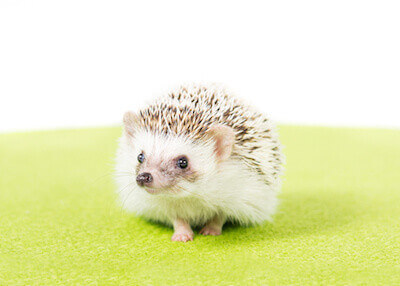How to Diagnose and Treat Ectoparasites
Wild hedgehogs of different species are often known to have issues with ectoparasites, which make their home on the skin. The most common infestations that occur with these hedgehogs are fleas, ticks, and mites. Such problems occur less frequently with domesticated indoor hedgehogs who are kept in a clean environment, but it is still important to closely examine the hog often. Symptoms of these infestations include itching, red and inflamed skin, quill loss, and anemia.
Fleas:
Fleas are not a serious issue for hedgehogs and can be treated with flea powder that will force the fleas to leave the skin of their host. For more serious cases, ask a veterinarian for advice on using stronger chemicals that are used on dogs and cats to exterminate the fleas.
Ticks:
Treating a hedgehog for ticks involves prompt and proper removal of the parasite to prevent infection and sicknesses. Using tweezers or a special tick remover, grab the tick close to the hedgehog’s skin and pull gently outward without crushing or twisting the tick to ensure no fluids or part of the parasite is left behind. Dispose of the tick in rubbing alcohol and use a disinfecting wipe to sterilize the bite.
Mites:
In the case of a mite infestation, it is best to consult a veterinarian. Based on the type and severity of the case, various medications may be prescribed and applied to the skin of the hedgehog. It is important not to use mite medications that are used for other animals without professional direction because these medications are toxic and will harm the hedgehog.
In the case of any sort of infestation, it is crucial to remove the contaminated bedding of the hedgehog’s home to fully get rid of the problem. Treat other animals and the living space in which the hog interacts to ensure that all parasites are removed.
How to Diagnose and Treat Intestinal Parasites
Intestinal parasites, such as intestinal flukes or tapeworms, can be a serious problem for a hedgehog if allowed to multiply, so it is important to treat these worms as soon as possible to avoid extreme illness or fatality. Worms are present in many hogs, especially ones that are brought from the wild, but serious infestations can occur when the hedgehog’s immune system is not strong enough to slow the rapid growth of the parasite colony.
Hedgehogs may be given various medications prescribed by a veterinarian that can be used as a preventative measure against worm infestations, but generally, small amounts of certain worms are not a worry if the hedgehog shows signs of being very healthy. With severe infestations of intestinal parasites, symptoms include weight loss, loss of appetite, anemia, diarrhea, bloody stools, and hyperactivity. Examine a hedgehog’s feces often to check for worms, but note that an infestation may be present even if worms are not visible.
To treat an infestation, contact a veterinarian who will help determine the species of worm and severity of the infestation and prescribe a treatment. These treatments may range from oral medications to injections. Antibiotics may also be given to get rid of any bacterial infections that are often associated with these parasitic infestations. Immediate action is important because, once a hedgehog shows these symptoms, it may have limited time before the infestation becomes fatal. Keep the hedgehog hydrated, offering plenty of water, and keep it warm by wrapping it in a towel or fleece material.
Further Reading:
Pet Hedgehog Care Guide
Should You Get a Pet?
How to Diagnose and Treat Fungal Infections
Dermatophytes cause common fungal infections, such as ringworm, in hedgehogs. These infections can be transmitted to humans and other pets, so it is important to treat this condition quickly while ensuring that it is done in a sanitary manner. A hedgehog may be a carrier of ringworm without showing visible symptoms of an infection, but visible signs may include loose spines or loss of spines and hair, cracked and flaky skin, weight loss, and scabbed areas.
Over-the-counter antifungal creams and shampoos can be used to treat ringworm, but give a quick call to the veterinarian to determine if these medications are safe for the hedgehog. Tea tree oil is also said to be effective in clearing mild cases of ringworm. If giving the hog a bath, make sure it is done in warm water and that extra care is taken around any cuts and scabs.
While treating a hedgehog, wear latex gloves and cover clothes that can be easily sanitized. Change the hog’s bedding daily during treatment to ensure that the infection doesn’t return, and keep the hog away from other animals and people. Be persistent with proper treatment, as cases of ringworm may take six months to fully clear up.
What is Wobbly Hedgehog Syndrome?
Wobbly Hedgehog Syndrome is a neurological disease that is most commonly found in African Pygmy Hedgehogs, but also can occur in other species. This is a progressive disease that causes loss of muscle control and muscular degeneration due to nerve damage. Paresis usually starts at the back of the animal and progresses forward over time, potentially resulting in complete paralysis.
Currently, there is no known cure for WHS, and the cause is not definitive, although it is suspected to be related to a genetic disorder. It is typically seen in hedgehogs that are between two and three years of age, but the syndrome can begin earlier or later in life as well. For a hedgehog who is diagnosed with WHS, the expected lifespan after symptoms are first seen can range from six weeks to 19 months.
Symptoms of WHS can come on quite suddenly, and progression to complete paralysis can happen over months or within a matter of days. The hedgehog will appear to wobble and will often fall over due to weakened muscles and nerve damage. Weight loss will also be apparent due to the atrophy of the hog’s muscles and possible difficulty in reaching its food. This syndrome sometimes affects only one side of the body, making it hard for the hedgehog to stay upright. Consult a veterinarian as soon as possible to help confirm the diagnosis, as these symptoms can also be a sign of other problems, such as a tumor or stroke.
Because there is no cure, the most that can be done is to ensure that the hedgehog lives comfortably for the remainder of its life. An important thing to consider is the quality of the animal’s life. If the hog is constantly in pain, is fully paralyzed, or refuses to eat, euthanasia may be the best option to prevent prolonged suffering.
There are several things that can be done to maintain a healthy lifestyle for a hedgehog that has WHS. It may be hard for the hedgehog to eat or drink so the use of a syringe can help the hog stay hydrated and maintain a healthy diet and weight. Propping the hedgehog up using towels, make-shift slings, or other soft items can help keep the hedgehog happy and prevent sores that may occur from laying on the sides frequently. Losing control of muscles may result in uncontrolled urination and defecation, so it is important to keep the hog clean, dry, and warm. Other measures, such as gentle massages and veterinary visits, can help keep the hedgehog as comfortable as possible.
My Hedgehog Is Foaming at the Mouth?
Foam around the mouth of a hedgehog is not a reason for concern, as this is a common action called self-anointing and isn’t a result of an illness. It is unclear as to exactly why hedgehogs self-anoint, but it is suspected that it occurs when they encounter an unusual food or smell, or when they consume a potent food that will help them hide their scent from predators. When this happens, the hog will contract its abdomen and regurgitate food and saliva, putting it onto the quills on the sides and back.
Prevent Illness from Routine Maintenance and Care
Keeping a hedgehog healthy and happy requires a fair bit of work that must become part of the routine of caring for it. Without proper care and cleaning, hedgehogs are more prone to developing diseases, contracting parasites, and a shorter life span.
Habitat Cleaning:
A clean habitat is important to prevent the growth of bacteria and breeding of parasites that may make a hedgehog ill. It will also prevent strong odors from circulating in the home. Remove excess waste from the cage and clean food and water dishes daily. Bedding and toys should be cleaned weekly and should be dry before they are placed in the cage.
Bath Time:
Hedgehogs are generally clean animals, and if the habitat is kept clean, other grooming will be required less frequently. However, dirt and other particles can get stuck in the many quills, so bathing is occasionally needed. When bathing a hedgehog, use warm water in which it can stand firmly and a splash of pet-friendly shampoo if desired. A toothbrush can be used to gently wash the quills from front to back. When finished, softly dry the hog completely before returning it to the cage.
Nail Trimming:
The toenails of pet hedgehogs need to be cut frequently because domestic settings typically do not wear down the nails naturally. Small pet clippers or regular nail clippers may be used, and it is very important to exercise care and patience when trimming the hog’s nails. Cutting the nail past the pink quick will result in pain and bleeding. When trimming, lay down a towel or soft cloth and tenderly hold the foot, giving the hedgehog time to calm down before beginning to clip.




This article is an exceptional guide for anyone fortunate enough to share their home with a hedgehog. The depth of information on diagnosing and treating hedgehog illnesses reflects a profound dedication to the well-being of these unique and delightful pets. The clarity and detail provided make this guide an invaluable resource for hedgehog owners facing the challenge of caring for a sick quilled companion.
My hedgehog is 3 years old. Recently she has been lethargic, green stools and has stopped eating. I took her to the vet who prescribed her antibiotics. After a few days she just started throwing them back up. I took her back to the vet they gave her a dewormer and lessened the dose of antibiotics. Her symptoms have gotten worse. She will not even eat mealies which are her favorite. I am at a loss and I do not know what else to do.
My little guy is active and eats and drinks fine. For over a year now he has had quill loss and intermittent flaky skin.
We give him baths every month and every month we give him medicine to prevent/treat mites. (We take him outside daily because otherwise he gets depressed. He also is pretty much potty trained..we take him outside a couple times a day..he will immediately pee and poop and then run)
We Lysol his cage every day. After which we triple rinse everything for safety. We were using “paper” bedding and now we use a lot of fabric instead. We change out the cloths every day and wash in hot water. We don’t keep his food near the cage either.
The vets aren’t positive what us wrong. I was hoping for some kind if possible idea from here.
He gets these small hard things that form on his skin. We have to dial it in water to soften it because otherwise it will tear a little skin off. He dies get new quills regularly. But he loses between 7 and 14 quills for every single new one. It’s not uncommon that when he loses a quill he will first get a huge pack of pus and then it will slide out and a lot of thick yellow pus will come out too (the vets usually brush thus off thinking I don’t mean medical pus until they see it and then they agree).
He doesn’t have itchiness either. He has been a little grumpier ever since it’s started.
Even if no one reads this within months if you have any ideas at all pls let me know. =) Thanks do much.
Sounds like a fungal infection. You will need to obtain some Imevarol from your vet to bathe daily for 2 weeks then best to use either athletes foot creams or tea tree cream, not oil. Please don’t put some on tummy, just in small affected areas. Use F10 disinfectant daily in their home and boil wash all bedding in non biological washing powder daily. All toys are to be scrubbed weekly. Ensure to use gloves at all times. If it doesn’t clear up in 6 wks its off to vets for a scrape to check for mites. In meantime can use Xeno 50 mini to cure or prevent mites. Good luck x
My heldgehog is approximately 4 years old. She has started to have bloody and mucosy stool. Upon examination, I see no Timor’s or growths. She is still active, and uses her exercise wheel nightly. She is eating and drinking as normal. Any ideas?
I would definitely see a vet and put some in a baggy just in case. (You can refrigerate it temporarily if you can’t take it in right away.
It could be a lot of things like something bad or something easier like a moment of bad constipation or hemorrhoids. Wish you guys the best.
having trouble breathing and blood coming from mouth